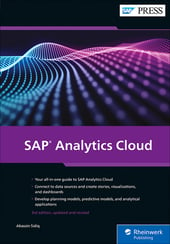Companies are generating gigabytes of data per second, but can they actually use it all?
More and more tools are appearing on the market to help analysts and planners, but not everyone is getting an edge. Is planning based on analytical data really a recipe for success, or is it just gazing into a crystal ball?
In this post, I want to talk about increasing the odds of predictions coming true and the changes needed to make effective use of data.
Most companies start by collecting data in Excel, Access, and similar tools. And that’s good enough for them. But as organizations grow, so does the volume and speed of data generation. We reach a point where it is easy to make mistakes and it is almost impossible (or very time-consuming) to manually verify the accuracy of the results. Companies are therefore investing in more advanced solutions like SAP to change this. But tools alone are not enough.
Data Culture
In the SAP Analytics Cloud solution, we can generally distinguish three groups of users. The first one includes people who create reports based on the information entered into the system. The second one is those who open reports, review data, describe it, and draw conclusions on its basis. The last group is casual users, i.e. those who sometimes need to find answers to specific questions in the system that will help them perform their daily tasks. In some organizations, the functions of groups one and two are combined into one.
Even the best analytical system cannot produce a reliable report or accurate prediction if the data is incomplete. Garbage in equals garbage out. That’s why you need to take care of your data culture in the first place.
Data culture in an organization means not only being aware of the need to complete data, but also caring about its quality, understanding the purpose of collecting information, and being aware of the possibility of using it for one’s own purposes. It applies to every level of management, from the rank-and-file employee to the board of directors.
We can only trust the final report if we trust the source data. You need to make sure it is completed correctly and on an ongoing basis. The easiest way to learn about an organization’s data culture is to talk directly to the people responsible for completing and processing the data. Although this may seem impossible, the cost is zero, and even a few interviews will provide information that will allow you to draw conclusions about the reliability of the data in a system.
We try to mention the importance of this element already at the pre-sale stage. As a result, the organization can start preparing earlier and take actions to communicate the change in accordance with the premises of SAP Activate. This all takes some time.
Training and familiarizing people with new tools is important in building a data culture. Training allows them to work with more confidence, and knowing how to use data can help increase their productivity. When they feel safe and comfortable, they will explore the new possibilities on their own.
A race car in the hands of an inexperienced driver is unlikely to set records and may even be dangerous. It is important to remember that analytical systems are a powerful tool for making decisions that affect entire organizations. Care must be taken to ensure that the venture does not end in disaster.
There are solutions that support the work of people responsible for data entry. They speed it up and minimize the risk of making mistakes. For SAP, this includes dictionaries or setting limit values. In the case of dictionaries, the user simply selects the appropriate option. Limit values, however, prevent the user from entering a number that is too large or too small. But they are not ideal. The pandemic has shown that in unexpected cases or in the event of anomalies, there is no way to make an entry in the system. Today, we have ready-made scenarios, and every SAP supplier is able to respond quickly to user requests.
Expectations vs. Reality
I often encounter situations where, when designing a solution, the vision of the end users is different from the vision of the decision makers. The reason for this isn’t just a lack of proper consultation and awareness of the issue and a lack of effective communication, but also a lack of awareness of the resources available and a complete picture of the needs. There are a number of issues that can be considered before selecting a supplier, which will allow you to better prepare your request for proposal.
While a margin of error can be tolerated in some SAP modules, it is unacceptable in the area of analytics, so the testing phase should be approached very carefully. Any error or unknown value will cause distortions, and a tool that cannot be trusted will not be used.
We are aware that systems, especially systems like SAP, are constantly changing. They evolve and adapt to the client’s business processes. Therefore, it is necessary to introduce modifications, create additional fields, or delete them. It is worth remembering that any change, even a small one, may affect the appearance of the final reports. In order to avoid the risk of errors or incorrect calculations, it is worth inviting specialists in the field of analytics to the discussions.
Time is Money
What many decision makers do not take into account when considering the cost of implementing SAP Analytics Cloud is the time saved by employees. In one of our implementations, it took two people several weeks to produce an annual report. Today, using addons like this analytics module, such a report is generated in a matter of seconds or minutes, and these people can devote their time to in-depth analysis and preparing comments on the presented results. Sometimes, in order to understand why certain data looks the way it does in a given period, these people run additional analyses to dig deeper into the issue.
Does this mean that the system has replaced the employees? No! It has freed up their time. Instead of spending hours creating tables in a workbook, they have time to analyze and interpret the results. Finally, they can discuss their findings and make recommendations. Do things they didn’t have time to do before, and provide a complete view of the situation instead of just numbers. This approach will speed up the development of an organization or help make decisions that are critical to its existence.
In today’s world, data and its skillful processing are of great strategic importance. According to Forrester, data-driven decisions in organizations with high analytical maturity are up to three times more accurate. MIT, in turn, points to better use of resources, increased productivity, and higher revenues. Attention to quality realistically translates into its use and therefore – return on investment and faster business growth. With a solution like SAP Analytics Cloud, you can get and use quality data in your business operations.
Learn SAP Analytics Cloud in Our Upcoming Rheinwerk Course!
Master SAP Analytics Cloud! Learn how to connect and model data, create visualizations, work with planning models, and use predictive analytics. This five-day course provides a comprehensive introduction to the core capabilities of SAP Analytics Cloud and its all-in-one BI functionality. Click on the banner below to learn more and order your ticket.
This post was originally published 3/2024.





Comments